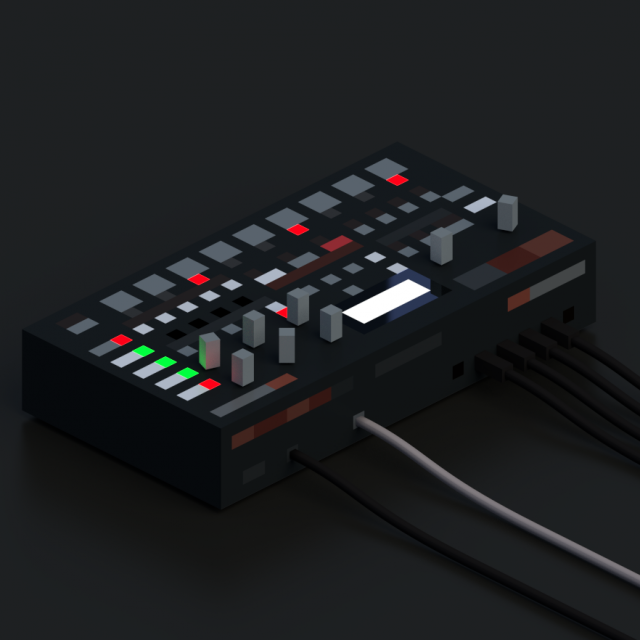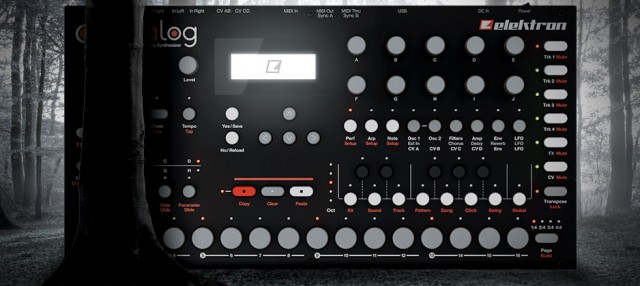
The Analog Four, stuff of dreams, as immortalized by eBoy in a parallel universe with a lower polygon count. (CC BY-NC-ND 3.0)
Following its endless teasers and science fiction mini-movies, Swedish machine maker Elektron this week has announced features, specs, and preorder pricing for its Analog Four synth/sequencer, along with some sample sounds and a promo vid.
It’s also been immortalized in a wonderful image, above, by artist eBoy. Just in case you needed a version to tack up above your bed.
Ahhhh….
The damage: US$1099 / 1099,– € including VAT, shipped. The date: December 3.
Yes, it’s analog, and even the early sound samples suggest a color of its own. And that’s a good thing. But, of ourse, that can’t be the whole story. Despite the name, mostly what the Analog Four appears to be about is sequencing and functionality, combining step sequencers with flexible routing for effects and (non-routable, fixed) serial analog filters (one for each voice). So once people get over the “analog” business, this is a box that will live and die on usability. (By way of illustration, I’ve heard from a number of people who fell out of love with Dave Smith’s Tempest for this very reason: if they didn’t get a good feeling from usability, they lost interest. The people who love the instrument do so for the same reason: they like the way it feels to use.)

Into the woods we go again. And I was really supposed to be getting to Granny’s house. Photo: Elektron.
That all-important combination of functionality:
- Voices: Two analog oscillators, two subs, noise oscillator on each voice.
- Two separate analog filters: 4-pole lowpass ladder filter, 2-pole multi-mode filter. They are fixed in serial, non-routable – but you do get two.
- Analog overdrive circuit for distortion.
- Effects: Wideshift Chorus, Saturator Delay, Supervoid Reverb. And here’s where we get digital – you start to get more flexibility in terms of how you apply and combine these effects.
- Step sequencer. This is the hybrid part of the whole arrangement: the digital step sequencer lets you control just about anything in terms of synths and effects, and you can even switch synth patches on each step, if you want to get completely crazy. You can also sequence external CV/gate for integration with analog gear.
- Sequencer tracks: four synth tracks, one effect track, one dedicated CV/gate track, 128 patterns, 64 step patterns, swing/slide/accent functions, six arpeggiators, parameter locks.
- Modulation: two assignable LFOs and envelopes per voice, AM cross-modulation, oscillator sync, dedicated LFOs for both PWM and vibrato.
- Patch storage.
- I/O: In addition to the typical outputs, you get MIDI in/out/thru (thank you, thru), USB, dual CV/gate outs, two external inputs.
- Dimensions: W340×D176×H63mm (13.4×6.9×2.4″)
- Weight: approximately 2.35 kgs (5.18 lbs)
Having that powerful step sequencer with integrated analog effects is where the Analog Four really shows potential. And speaking of usability, the control layout does look eminently logical, with direct key access to tracks, dedicated parameter knobs, and a balanced layout providing note access (with black and white buttons, natch) and quick access to editing.
Update: One major cause for concern is the absence of MIDI output from the step sequencer. Thanks to commenters for pointing this out.
Does the Analog Four have dedicated MIDI sequencer tracks?
No. Instead it features a dedicated CV/Gate track, controlling the two dual CV/Gate outputs.
What you can do with MIDI output is not output MIDI messages, but only MIDI sync. So, if you’re sequencing the step sequencer only with CV hardware, or you have another piece of gear with a sequencer in it and only need sync, this isn’t an issue. If, on the other hand, you were considering the Analog Four as the hub of some digital gear – yes, it’s an issue. Here’s hoping this is something that gets addressed in a firmware update.
That’s the bad news; back in the good news category (update)… Simone Ghetti notes that while you can’t re-route the filters, you can use them with external inputs. Now, this gets very cool:
The filters for each of the 4 voices can be used to treat incoming audio from the inputs essentially creating a sequence-able filter bank. Seeing what filter banks go for these days, it adds a whole level of functionality to the unit beyond the synth section.
Elektron’s promo video gives an overview (in short order) of how they see these features coming together:
But much better viewing is this jam by Project Dataline – aka Cenk Sayinli (Jake). In this first video, he jams with the machine and demonstrates how useful it is having access to those dedicated parameter knobs and quick-edit menu keys. Jake is dedicated to hardware workflows. Project Dataline focuses exclusively on Elektron machines. Previously based in Istanbul and the UK, his apparent love of Sweden has him now located in the belly of the beast, Elektron’s home Goteborg, Sweden. (Little wonder how he managed the first hands-on, then.)
It’s not only Elektron, per se. While he works with the Machinedrum, Monomachine, and Octatrack, he also has the creation of Elektron veterans in the form of Teenage Engineering’s OP-1 – and has done an OP-1 track on a compilation of OP-1-only music.
More on his music:
http://www.projectdataline.com/
(Oh, yeah, and bonus – by coincidence, he also collaborates with Radek Rudnicki, as covered here yesterday.)
Have a listen to Elektron’s official sound set, which includes some tasty examples:
I just want to touch and hear the thing, especially as the audio samples posted so far are a bit mixed. Experimental sequences are sounding fantastic; some of the basslines are sounding a bit vanilla. (I really, really shouldn’t be critical of these things, as I badly botched early sound samples of our own MeeBlip synth. So, yes, I know it’s hard to do demos. Just have a listen, keep an open mind, and stay tuned for people to get these things.)
To skip to the things that make my blood actually start pumping (dunno about yours), try out the Experimental Sequences – particularly the second one, with some beautiful noise and distortion.
I do also wonder what the breakdown of this equipment’s audience will be. Elektron has always made instruments for hard-core enthusiasts. At the same time, will this mostly attract analog lovers with its CV I/O, or will that be secondary as an audience of producers chooses its “analog”-ness for sound?
Regardless, I think there’s little question this is one of the more compelling recent product intros – arriving just in time for Christmas.
http://www.elektron.se/products/analog
What strikes you about Analog Four – and what would you want to know about it? Let us know.